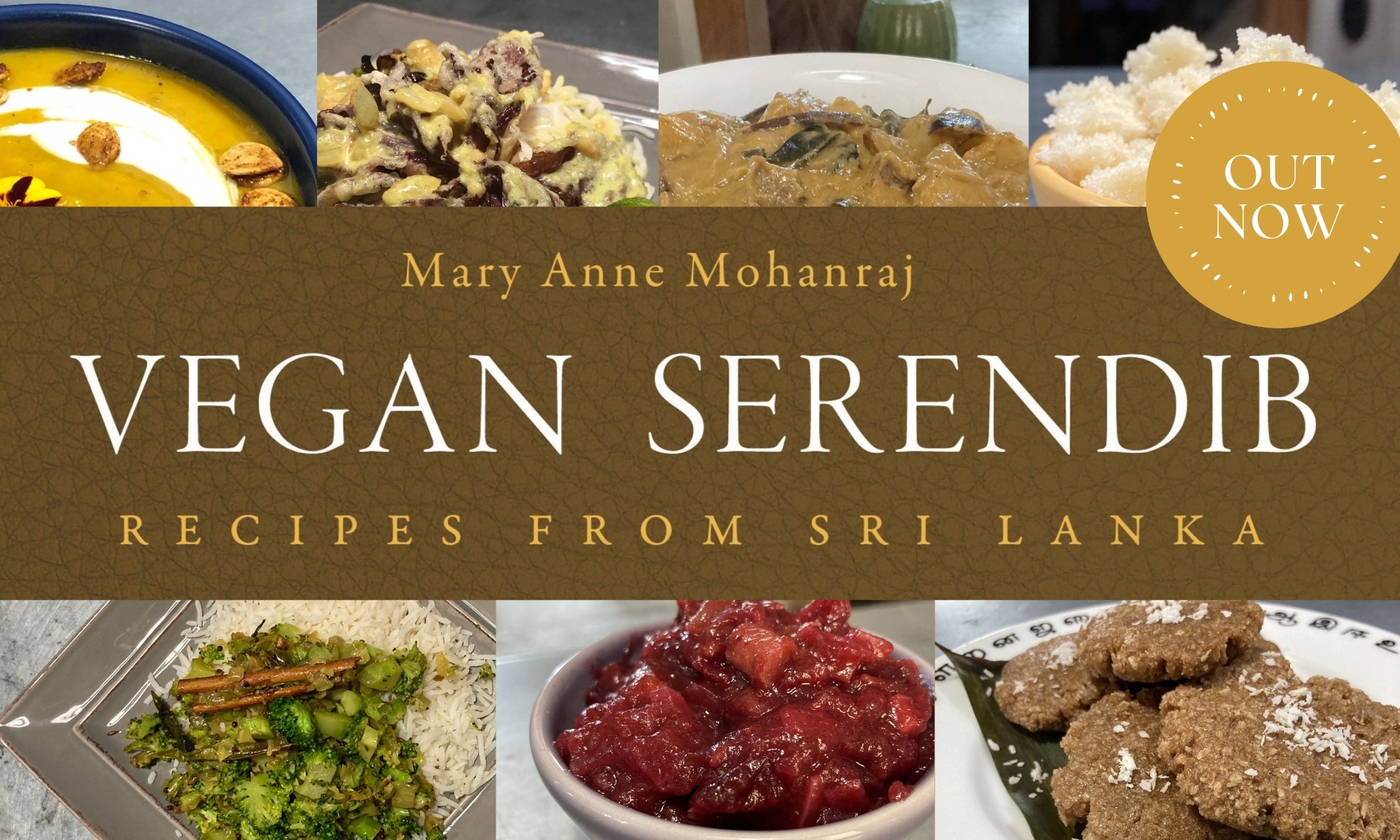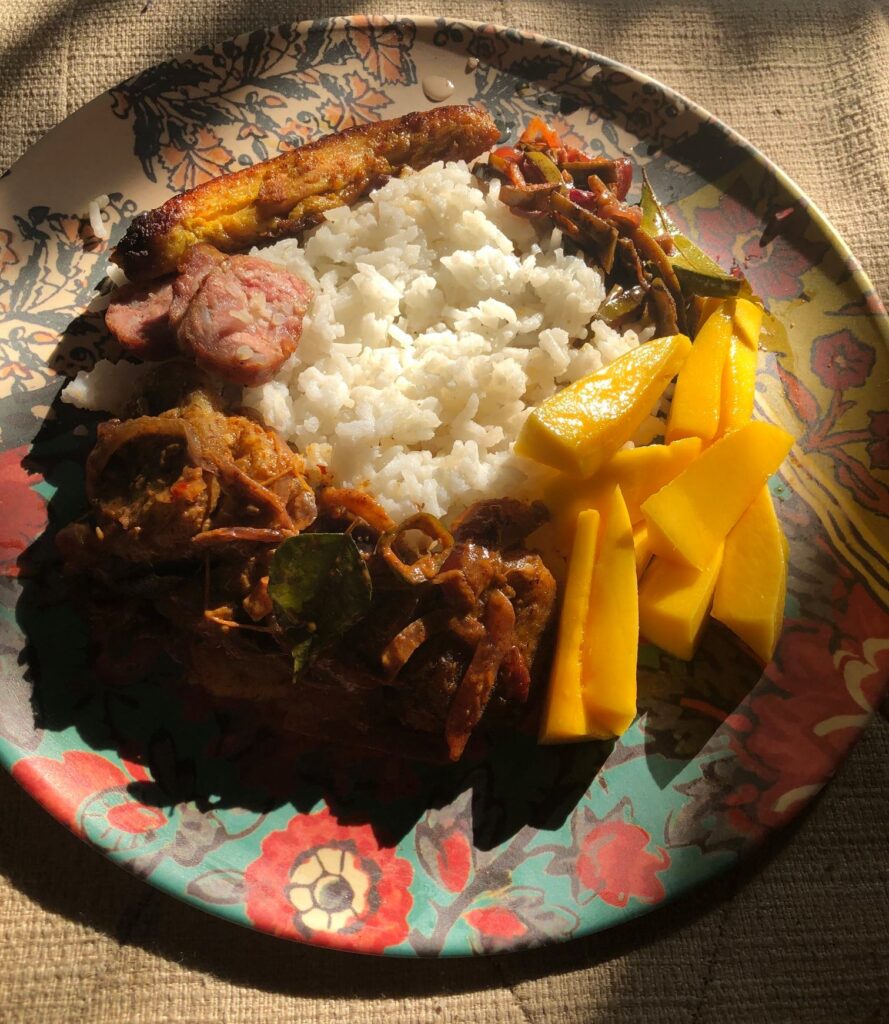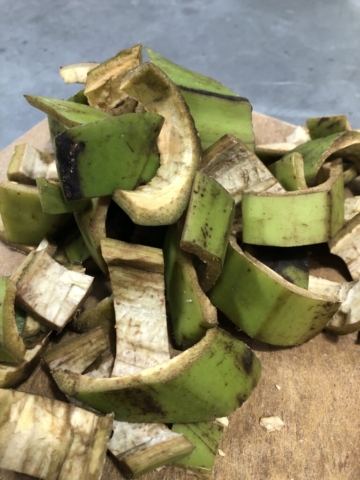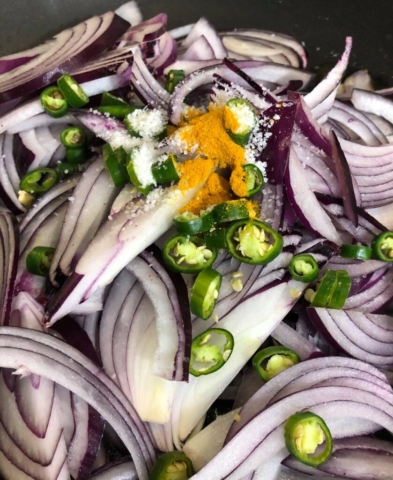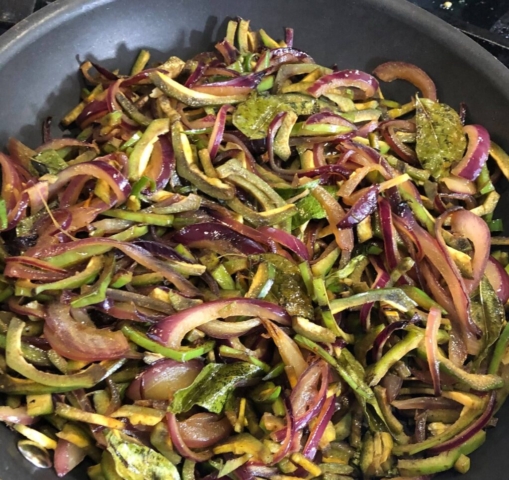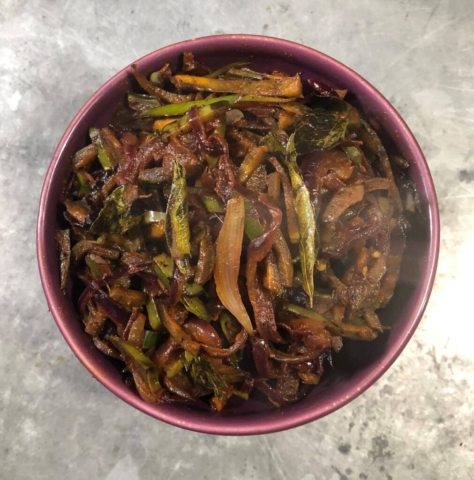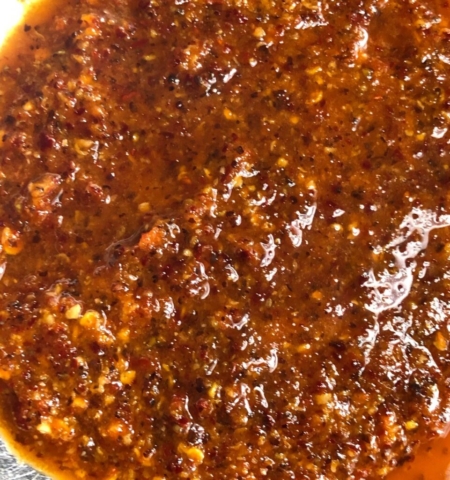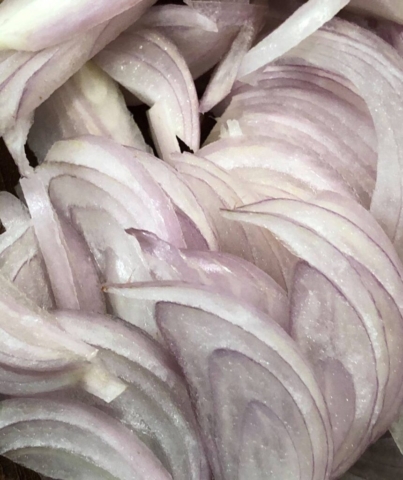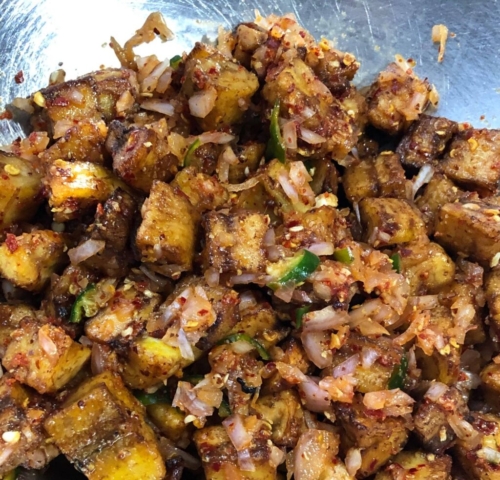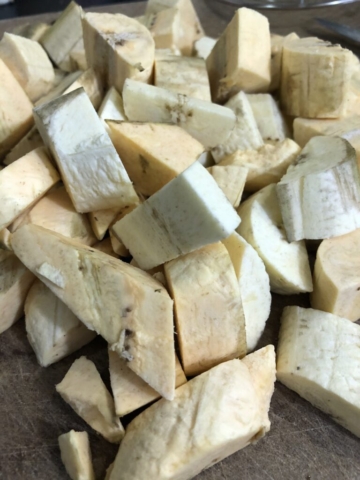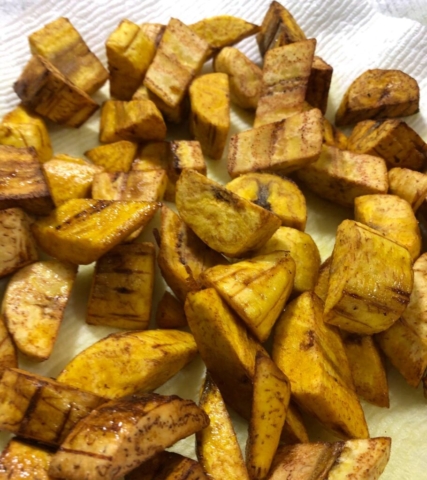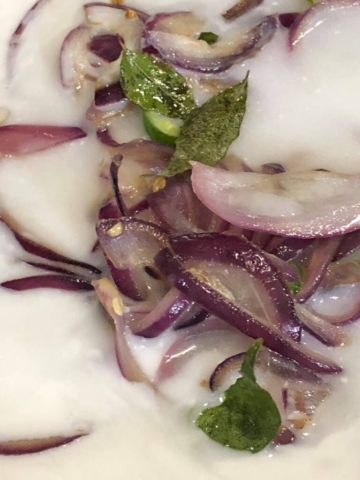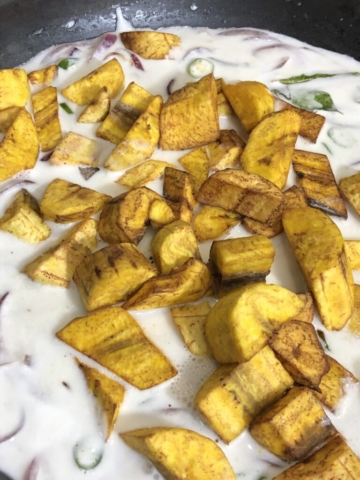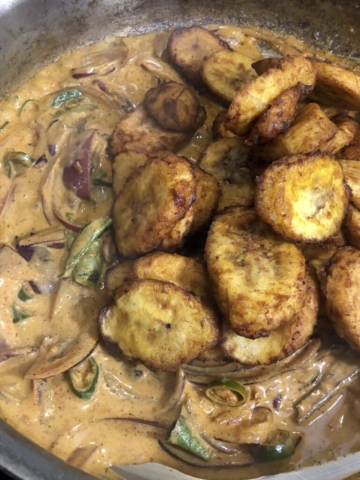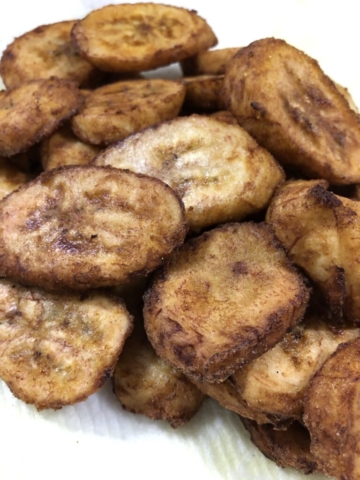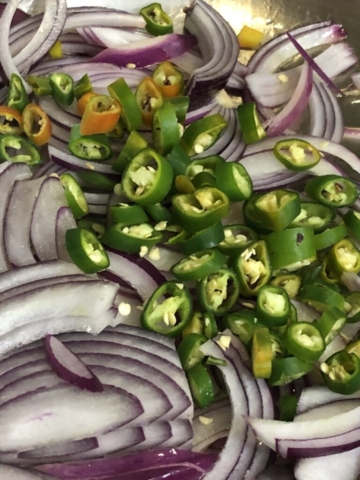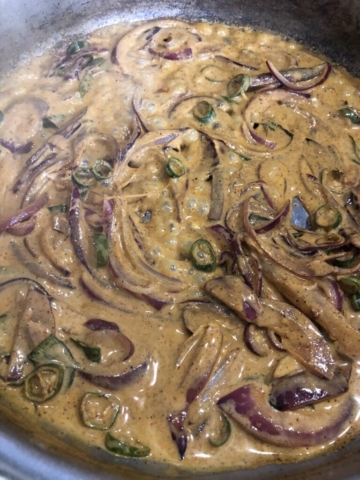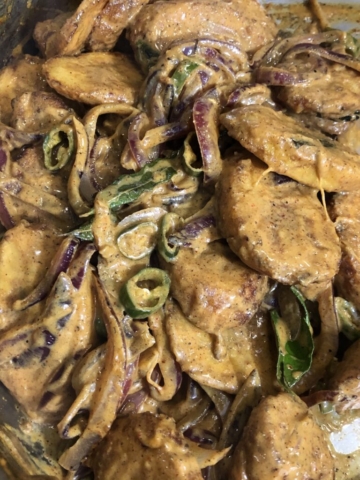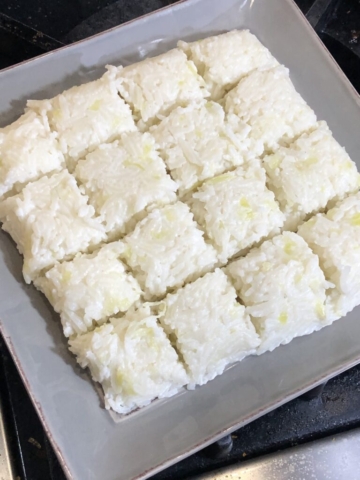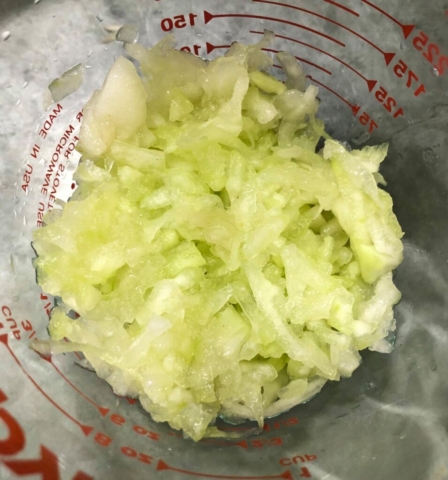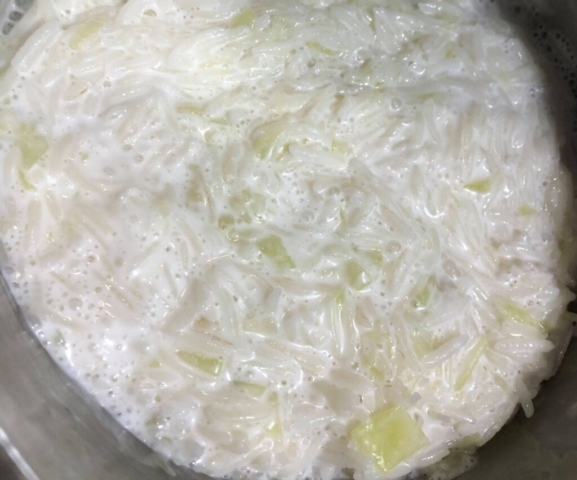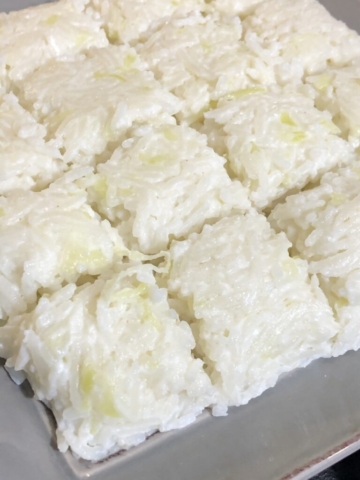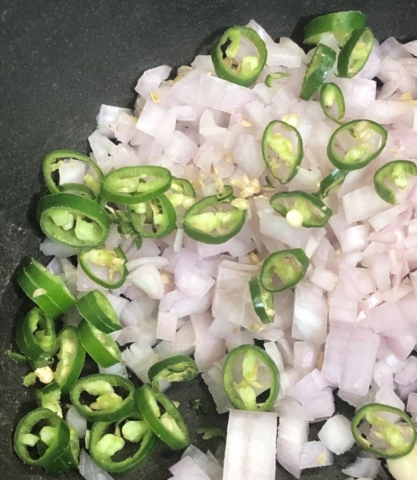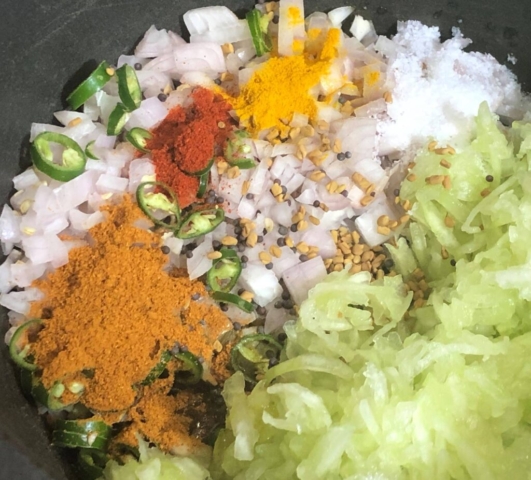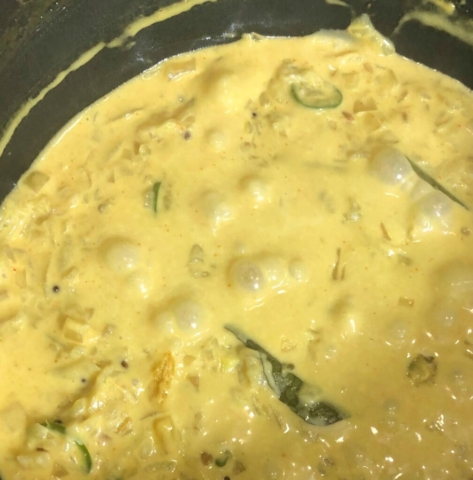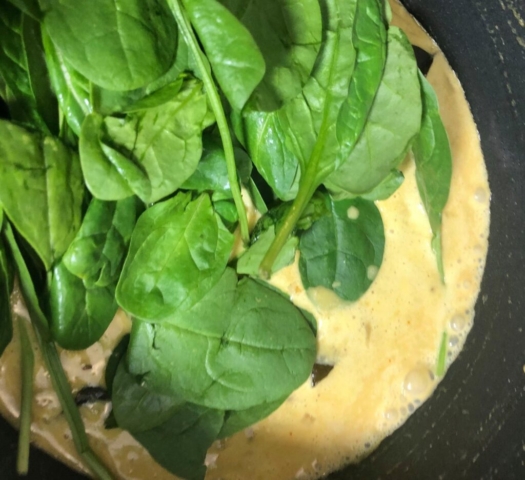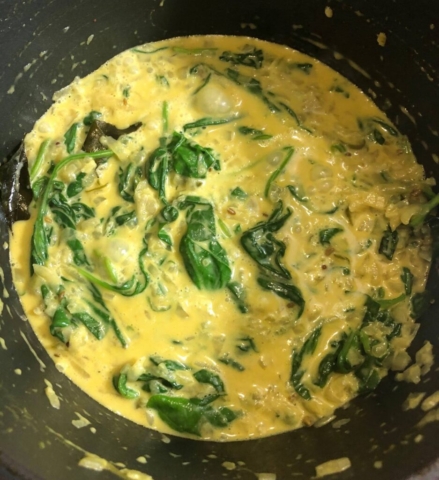Chilly outside, but a little tropical sunshine on my plate. I’m cooking mostly vegan food these days, developing recipes for the cookbook, but we’re also still trying to support our local restaurants — we got Thai takeout last night, so there’s a little Thai sausage and chicken satay on the plate, then going clockwise, tempered plantain peel, fresh mango, and spicy plantain curry. Luxurious.
Tempered Green Plantain Peel
(20 minutes, serves 8 as accompaniment)
I was raised a frugal New Englander, and I truly hate wasting food. So you can imagine how excited I was when I learned that plantain (and banana) peel is actually edible! I like making this with green plantain peel, for the color contrast with the red onion, but you can also use ripe plantain, or green or ripe banana peel.
1 T lime juice
1. Heat oil in a frying pan; add sliced peel, red onion, green chili, curry leaves, cayenne, turmeric, and salt. Sauté on medium, stirring occasionally, until peel is cooked through and a little crispy, about 10-15 minutes. If it starts sticking, add a little water and scrape it up.
Plantain Sambol
(20 minutes, serves 4 as accompaniment)
Plantains are staple foods throughout Sri Lanka and the region, the main fare of millions of people for centuries. They’re rich sources of complex carbohydrates, vitamins, and minerals, and are easily digestible. This traditional Jaffna-style plantain sambol offers a luscious, spicy-tangy bite, and is a great way to perk up a plate of rice and curry.
1/2 t. salt, optional
1. Peel plantains and dice, then toss with 1/2 t. salt and turmeric.
2. Heat oil and fry diced plantain until golden; remove to a plate lined with kitchen towels and set aside.
3. Combine dry chilies, vinegar, mustard seeds and sugar to a smooth paste (in a blender or using a mortar-and-pestle).
Green Plantain Curry
(45 minutes, serves 4)
Green plantains are starchy and not sweet, more like a vegetable than a fruit — if you’ve had tostones, those are made from green plantains. Expect these fried green plantain bites to be much like potatoes in texture, but with a flavor all their own; I like them simmered in a mild coconut milk curry, with just a hint of green chili.
NOTE: You can save plantain peels to cook them too.
1-2 T lime juice
1. Cut plantains in half lengthwise and remove peel with a paring knife. Slice plantains on the diagonal in roughly 1/4″ slices, then toss with 1/2 t. salt and turmeric.
2. Heat oil and fry plantain slices until golden; remove to a plate lined with kitchen towels and set aside.
3. In a separate large sauté pan, heat 1-2 T of the oil and add onion, chilies, curry leaves, fenugreek seeds, and salt. Sauté about 10 minutes on medium-high, stirring occasionally, until onions are softened and translucent.
Spicy Plantain Curry
(30 minutes, serves 4)
Sri Lanka grows a host of plantains and bananas; this type of curry is typically made with a variety known as ash plantain. That’s not easy to find in America, but luckily, plantains generally have become much more available, and they work beautifully in this dish. You can even use very green bananas if you like.
After the first frying stage, the plantains should be just a little bit sweet, and can be eaten straight up if you like as a snack, or added to a plate of rice and curries. But add them to this curry sauce, and the spicy, tangy sauce meets the sweetness of the fried plantain, for what I can only call a taste explosion. In a good way!
NOTE: You can save plantain or banana peels to cook them too.
1-2 T lime juice
1. Slice plantains on the diagonal in roughly 1/4″ slices, then toss with 1/2 t. salt and turmeric.
2. Heat oil and fry plantain slices until golden; remove to a plate lined with kitchen towels and set aside.
3. In a separate large sauté pan, heat 1-2 T of the oil and add onion, chilies, curry leaves, and fenugreek seeds. Sauté about 10 minutes on medium-high, stirring occasionally, until onions are softened and translucent.
4. Add cayenne, curry powder, and 1/2 t. salt, and stir a few minutes more, then stir in coconut milk.
Stronger Together
All the curry powder I roasted this weekend is spoken for now; very satisfying, getting it fresh and out the door quickly. (I’ll start prepping to roast another batch when the next order comes in…I’m out of cloves, so have to get some more of those first!)
Some curry powder packets were individual sales, but many were packaged with copies of Feast (hardcover and paperback). Three of those were birthday presents, which I find particularly lovely. What a nice thing to do for a friend, to introduce them to cooking a new cuisine. ![]()
Maybe I’m a little over-emotional, after long pandemic and with the election bearing down on us. It does make me happy, to see how in difficult times, we take care of each other and put in a little extra effort to strengthen bonds. Stronger together, right?
Fiberworld Grind-a-long
Quick save-the-date that I’m going to host a free virtual spice-grinding demo / grind-a-long for Fiberworld on November 18, 5:30 CST. I’ll show you how to roast and grind spices for your own Sri Lankan curry powder blend, and answer any questions you might have for 45 minutes or so. Followed by an hour of knit-a-long and chat, hosted by Fiberworld.
Flyer with more details to follow. ![]()
Sri Lankan Milk Rice / Kiri Bath
(with Bottle Gourd variation)
Kiri bath (pronounced ‘buth’), rice cooked with coconut milk, is an essential part of Sinhalese culinary tradition in Sri Lanka. It’s a required element on New Year’s Day (celebrated in April on a lunar cycle), and often eaten on the first day of each month. Kiri bath is generally served with lunu miris or other spicy sambols, although some prefer it sweet, with jaggery.
Sri Lanka has been a multi-ethnic society for over 2000 years, and when my parents’ Sinhalese neighbors made kiri bath, they would always bring some over to share with their Tamil friends. I didn’t grow up cooking it myself, but it was always a particular treat when my Sinhalese friends made it for me. I love kiri bath with pol sambol plus a nice curry, and a little paruppu (dal / lentils) never goes amiss. Maybe a bit of brinjal moju (pickle) too!
I ran across an interesting variation through a cooking video (by Chandeena and her mother at Village Life: https://www.youtube.com/watch?v=8EYvQ3S9ayU), where you add bottle gourd to the dish — it lends a lovely delicacy to the finished kiri bath, and may also serve to lighten it up a bit, for those who love the richness of flavor, but are perhaps being careful about their portion sizes of luscious rice and coconut milk.
2 c. shredded bottle gourd (or cucumber), optional
1. Put rice, bottle gourd (if using), and water in a pan and bring to a boil; cover, reduce heat to medium, and cook 15 minutes. The rice should be mostly cooked at this point, but it’s fine if it’s a little firm still.
2. Add coconut milk and salt, stir well. Cover the pan again, turn heat to low, and cook for a further 10-15 minutes, until the milk is entirely absorbed.
Bottle Gourd (or Cucumber) and Spinach Curry
Bottle gourds are one of the original immigrating foods, their seeds drifting across the ocean and making their way from Africa around the world to North America, South America, and Asia, over 10,000 years ago. Amazing!
Because bottle gourd (Lagenaria siceraria) is also called calabash, they’re sometimes confused with the hard, hollow fruits of the unrelated calabash tree (Crescentia cujete).
Bottle gourd flesh is mild, very similar to cucumbers, but a little sweeter. Young seeds and bottle gourd skin are also edible, so you might want to save those for other dishes. But for this curry, you’ll be working with the flesh of the vegetable.
This is a simple curry on its own (lots of spices, but very few steps!), and can be easily varied by adding eggplant, lentils, or in this case, fresh spinach. Bottle gourd also makes a nice stir-fry (varai), or soup.
1 bag baby spinach leaves (about 4 oz.), optional
1. Heat oil in a pot, and add onions, garlic, spices, and bottle gourd. Sauté, stirring occasionally, for 10-15 minutes, until onions are golden and a little browned.
Compote Comfort
I wanted dessert last night, something fruity, but not too rich. I sliced a slightly underripe pear and a few similarly underripe figs, then sautéed them for a few minutes in butter. Added a drizzle of bourbon maple syrup, and it was done. Moderately healthy, for a dessert, since it’s mostly fruit, and delicious.
